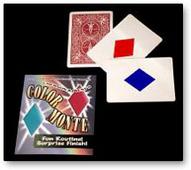Color Monte
Temple, Jim
Emmerson & West
(Based on 3 reviews)

Reviews
(Top ▲)
A classic packet phenomenon indeed! I first learned this trick over a decade ago, in its original form. As I am not too fond of gambling stories, or the script that comes with the trick, I revisited the routine, using cards from a standard deck. The routine is brilliant in terms of how the cards move around, and the punchline simply kills! I perform the effect using an ace of spades, a joker, and the queen of hearts as my punchline card. Every time I show this effect to people, they either look up my sleeves, jump on the cards thinking they're trick cards, they scream. Eyes pop, jaws drop....or all of the above! I never particularly cared for the cartoon card that comes with the original version, so I just came up with a handling and cards that suit my style. Unlike the gem that is Michael Skinner's Ultimate Three Card Monte, these cards can be examined at finish. It's definitely worth purchasing, whether you stick with the original cards/routine, or retool it to your own preference. I still can't believe how much high impact just three little playing cards can have, but it's true!!! It blows (even jaded and suspicious) people away!
(Top ▲)
That's right kids, color monte. One of the packet tricks that started it all. Started what you ask? Why specially printed cards that people think are hyper color. (Rememebr those from the 80's?) The cards come in the standard black packet trick case and have those little instructions that vaguely explain an elmsly count and whatever that other move is called.
Now don't get me wrong. I think everone should own this at one point or another. It's a staple. (like a hole in the head it is.) However, after you learn it, use normal playing cards. It's better and there is less to explain. Also learn what is called a flustration count and add it to the routine. Much more effective.
It only uses three cards, two moves and a killer ending. It's easy to do and fits into a pocket or card box. You do the math.
Bizzaro.
Now don't get me wrong. I think everone should own this at one point or another. It's a staple. (like a hole in the head it is.) However, after you learn it, use normal playing cards. It's better and there is less to explain. Also learn what is called a flustration count and add it to the routine. Much more effective.
It only uses three cards, two moves and a killer ending. It's easy to do and fits into a pocket or card box. You do the math.
Bizzaro.
(Top ▲)
Three Card Monte. The words alone are enough to inspire terror and panicked flight in the most hardened spectator of magic. Everyone and his dog has a three card monte variation, but they all seem to have the same patter, lifted doubtless from the original three-card-monte dealer seen on the street.
This one, Color Monte, has a few differences which might help lighten the level of pasteboard ennui. The use of non-standard cards and a genuinely amusing patter leads to no 'dead time' waiting for the spectator to choose anything. The fact that in this routine it's the magician himself who gets fleeced makes it particularly audience-friendly and gets the spectators to laugh with the magician (or is it at?).
Mechanically, the trick requires two card moves which, if you've done any amount of card handling, should come easily. If you haven't, the instructions may not be completely clear on the moves in question. I strongly recommend watching the demo at http://www.magictrickshow.com to see an audience-eye-view of the moves as that clears things up a great deal (and hearing the patter's 'live' isn't a bad thing either).
The trick packs small, plays to a reasonable number of people, and it's less than $10. A nice one to keep in your arsenal if you do any sort of walk-around and are willing to portray yourself as the 'mark'.
This one, Color Monte, has a few differences which might help lighten the level of pasteboard ennui. The use of non-standard cards and a genuinely amusing patter leads to no 'dead time' waiting for the spectator to choose anything. The fact that in this routine it's the magician himself who gets fleeced makes it particularly audience-friendly and gets the spectators to laugh with the magician (or is it at?).
Mechanically, the trick requires two card moves which, if you've done any amount of card handling, should come easily. If you haven't, the instructions may not be completely clear on the moves in question. I strongly recommend watching the demo at http://www.magictrickshow.com to see an audience-eye-view of the moves as that clears things up a great deal (and hearing the patter's 'live' isn't a bad thing either).
The trick packs small, plays to a reasonable number of people, and it's less than $10. A nice one to keep in your arsenal if you do any sort of walk-around and are willing to portray yourself as the 'mark'.








